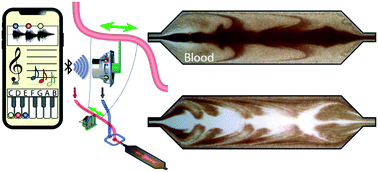Generation of programmable dynamic flow patterns in microfluidics using audio signals†
Abstract
Customised audio signals, such as musical notes, can be readily generated by audio software on smartphones and played over audio speakers. Audio speakers translate electrical signals into the mechanical motion of the speaker cone. Coupling the inlet tube to the speaker cone causes the harmonic oscillation of the tube, which in turn changes the velocity profile and flow rate. We employ this strategy for generating programmable dynamic flow patterns in microfluidics. We show the generation of customised rib and vortex patterns through the application of multi-tone audio signals in water-based and whole blood samples. We demonstrate the precise capability to control the number and extent of the ribs and vortices by simply setting the frequency ratio of two- and three-tone audio signals. We exemplify potential applications of tube oscillation for studying the functional responses of circulating immune cells under pathophysiological shear rates. The system is programmable, compact, low-cost, biocompatible, and durable. These features make it suitable for a variety of applications across chemistry, biology, and physics.



 Please wait while we load your content...
Please wait while we load your content...